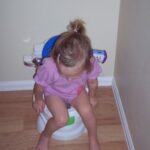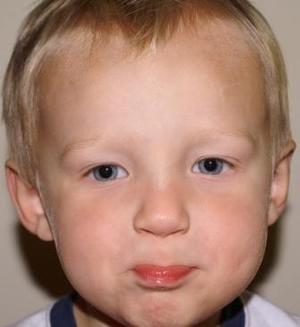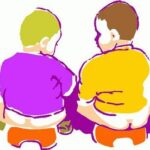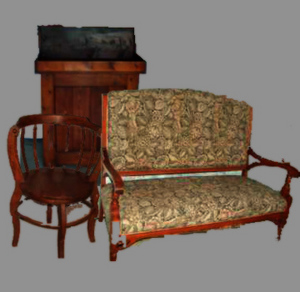Perhaps the most important consideration in deciding when to potty train a child is recognizing when he is “ready” to be trained. Some children are ready at 18 months, others at two years or older. In my experience both with our own children and observing this process with others it is important to not delay the process once the child indicates that he or she is ready to be trained. Mothers and Dads who put off potty training until a child is three, or four years old, perhaps in hope the child will train himself, will find potty training much more difficult and tensions between parents and child significantly higher.
So how do you determine when a child is ready for potty training?
I would consider evaluating whether a child is showing signs of being ready for potty training at 18 months.
First, observe how often and what time of day your child wets (or poops) his diaper. New- born babies may soil a diaper as often as hourly as they consume lots of liquids and have a very small bladder. As children grow the frequency of wetting and pooping is reduced. The bladder size has grown, muscle control has improved and the intake of liquids becomes less frequent. Solid foods are introduced so that poops are now more solid and occur less often.
To determine how often and when your child is soiling his diaper you will need to check his diaper often, perhaps hourly. Make a mental note, and if necessary written notes, of how often he is wetting and how often he is pooping. It will also help to note whether these events are occurring at certain times of day.
For example, if your child consumes 3-4 ounces of milk or juice at 8:00 AM how long can/does he hold it before wetting his diaper? Immature children will wet within the first hour or two, while others may hold this amount much longer.
Similarly, observe how long after the intake of solid foods your child waits before pooping. Healthy adults generally have bowel movements on a regular schedule daily. Babies will do that too, but have to develop the habit.
When your child begins going 3 or more hours before wetting his diaper you should consider potty training.
The next step is to purchase a potty. In our family we prefer the stand-alone potty for reasons that will become obvious later. A stand-alone potty consists of a small child size chair with arm-rails and the obvious removable potty bowl resting beneath the chair in the center of a ten-inch in diameter hole in the seat. These may be purchased in any baby supply store and range in price from $20 to $100. The $20 potty serves as well as any of the more expensive options. When training a boy it is a must to purchase a potty that includes a cup shield. This shield clips onto the front of the potty bowl and deflects any powerful stream that may randomly occur if the little fella’s equipment is not properly aligned (downward into the bowl).
Once the potty is purchased introduce it to the child. Designate a special place for it (the place where training is to take place). This special place does not have to be the bathroom. It should be a place where the child is comfortable and can be observed by the parents. Do not make the mistake of placing the potty in some dark place, where it is hidden from view, as the child will associate the potty and potty training with such a place.
Allow the child to sit in the potty chair (prior to training). Explain to him this potty is his just as the potty in the bathroom belongs to mom and dad. You may want to write his name on it with a liquid marker.
Once the child has shown signs of holding his bladder and bowel movements for longer periods and is indicating he is ready for training make the decision to begin potty training.
Tell the child that you are going to teach him how to use the potty just like mom and dad do. Make it a special event marked by a notable change from diapers to training pants.
Training pants are heavy, doubled layered underpants which like diapers can absorb some liquid, but are the first step to real underwear. My wife believes firmly that once potty training begins the child can no longer wear diapers, even at night. The conversion to “big boy” training pants signals a real change for the boy being trained. This change, like the requirement to use the potty must be permanent.
The next step is to develop a schedule for training. Using notes taken while observing the reduced frequency of diaper wetting plan potty training around the time you expect him to pass urine. For example, if your observations noted that he usually wets his diaper three hours after breakfast and again three hours after lunch and dinner schedule potty training at those intervals.
Let’s assume breakfast is at 8:00 AM, Lunch at Noon, and dinner at 6:00 PM. Assuming a three-hour time between observed wettings you would schedule potty training at 10:45 AM, 2:45 PM, 5:45 PM and at bedtime.
At those scheduled times place the boy on the potty and tell him that when he feels ready he should “pee” or “poop” in the potty. It should be made clear to him that whether or not he has results he must sit on the potty for twenty minutes. To make this more agreeable my wife always maintained a “special” cache of favorite toys that could be played with only while on the potty. She would place a small child’s table with three or four favorite toys in front of the potty and within reach of the potty sitter. Our boys would sit on the potty for long periods of time (awaiting action) entertained by these “special” toys. These special toys would be rotated from one potty session to the next and could only be played with while on the potty. More often than not these toys would occupy our sons until they had a potty success.
It is vitally important to the training process that you never let the child shorten or refuse to stay the scheduled time on the potty.
Success may come slowly, but with patience and persistence it does come. We asked our boys to announce when results was achieved on the potty and as a family we would gather around the potty and observe the “accomplishment” and give arousing cheer and round of applause with each successful potty deposit.
It is important to give equal recognition to any successful use of the potty. Quantity of pee or poop should not matter. Every trickle and every speck deposited must be cheered on as a success.
Understand and expect accidents. These are most likely to occur while sleeping, as most children will find it difficult to hold urine through the night. Do not scold them for this. Do not give in to the temptation to use diapers at night as this is seen as a concession/failure.
If accidents occur during the day remind the little fella that it is important to use the potty as daddy and mommy do (or perhaps a big brother or sister).
It is very important to be firm. Never discontinue the potty schedule or routine. Starting potty training and then giving up only it makes it doubly hard the next time!
Do use praise and rewards for success. As mentioned my family always gave a rousing cheer and much applause in recognition of every pee and every poop. I never knew how much this meant to my son until one day when I took into a public restroom where after completing his business he carefully watched the man standing next to us do the same only to be greeted by my 3 year old son’s loud clapping and words of congratulation for the confused stranger.
Potty training is difficult and can be stressful. I have observed my wife as she mastered this process by insistence on a schedule, rewarding success and never ever giving in.
You can do it too.





